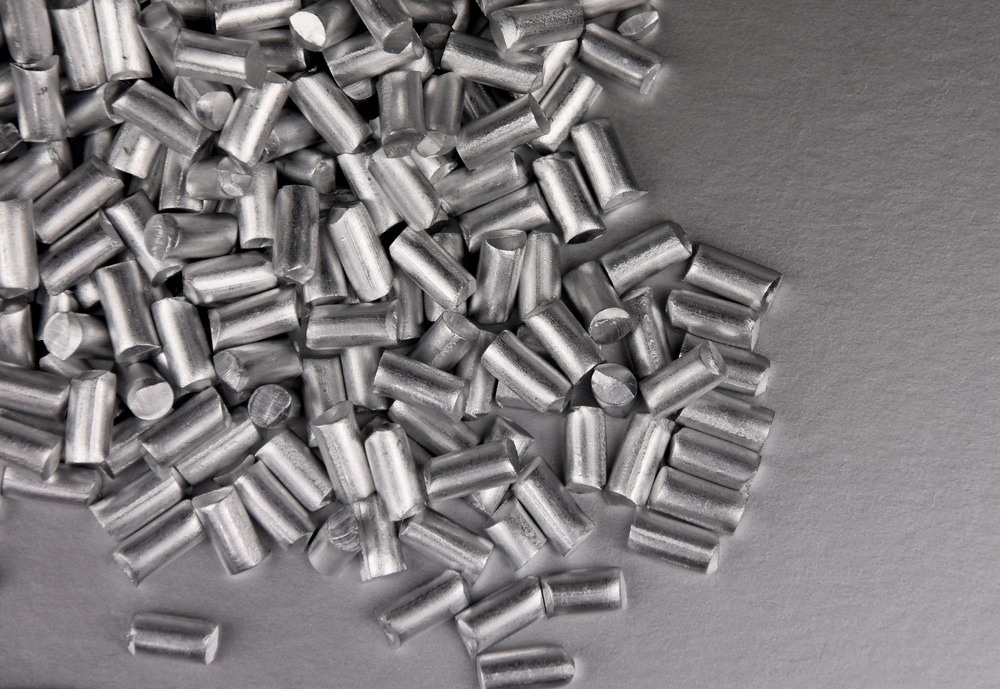Scientists from TU Dortmund University in Germany have collaborated on a new paper studying the stress tolerance of Al-Si alloys. Their work has appeared in the journal Additive Manufacturing Letters.

Study: Uniform Fatigue Damage Tolerance Assessment for Additively Manufactured and Cast Al-Si Alloys: Size and Mean Stress Effects. Image Credit: BeataGFX/Shutterstock.com
Background to the Research
Aluminum-silicon alloys are commonly used for manufacturing products for the railway and automotive industries. These important alloys possess low density and excellent castability, which allows them to meet the stringent demands of these industries.
Another advantage of these materials is that they can be easily fabricated using additive manufacturing techniques. They are classified into eutectic, hypereutectic, and hypoeutectic alloys. Age-hardening is commonly used during manufacturing to induce peak hardening during heat treatments.
Process-induced defects such as intermetallic precipitates, oxides, and porosity can seriously affect the properties of the final product, such as fatigue resistance. Additive manufacturing, whilst it has improved in leaps and bounds over the past few decades, as well as casting methods, can only reduce process-induced defects and not eliminate them completely.
Other processes have been developed to improve the final manufactured products, such as hot isostatic pressing, but are costly in terms of manufacturing time and materials. Therefore, there has been a growing research focus on investigating the effect of process defects and evaluating how the final mechanical and physical properties of Al-Si alloys can be improved.
The Research
The authors have evaluated the effects of process-induced porosity, microstructure, defects, and stress-strain behavior on Al-Si alloy materials manufactured with both casting and additive manufacturing methods. Moreover, the fatigue damage tolerance of these industrially important materials has been analyzed in the paper.
Manufacturing methods employed in the study were powder bed fusion utilizing laser beams (an additive manufacturing method) and gravity-sand casting for cast alloys. Different alloys were analyzed by the authors. Cast materials were T6 and hot isostatic pressing treated, whilst the additive manufactured alloys were investigated in their as-built configuration.
In the research, the macro hardness of both the additive manufactured and cast Al-Si alloys was kept comparable. Incremental step tests and tensile tests were employed to determine both the cyclic stress-strain and quasi-static behaviors of the analyzed materials.
Several analytical approaches were employed in the paper to investigate fatigue behavior over a range of stress ratios. Approaches included different elastic-plastic and linear-elastic mechanical methods. These were used to demonstrate the effects of mean stresses upon the materials.
Due to significant mean stress and size effects, the authors have stated that Woehler curves could not be adequately quantified. This had an effect on achieving uniform lifetime predictions. However, the effects of mean stresses and defects, along with size effects, could be considered using cyclic SIF methods which include mean stress extensions. Using EPFM approaches to modify analytical methods takes into account the effects of cyclic plasticity.
The authors have stated that taking into account multiple effects such as stress ratio, defect position and size, stress amplitude, and others can help to realize an analytical benchmark to achieve a stepwise improvement in the analysis of process-induced defects in Al-Si alloys and their effects on product properties such as fatigue behavior.
In Conclusion
The new paper in Additive Manufacturing Letters has investigated analytical methods for the determination of product defects and their effect on the final mechanical properties of aluminum-silicon alloys. Materials produced using both additive manufacturing methods and casting techniques were analyzed and compared.
Several analytical methods have been employed in the study to investigate how a uniform stepwise fatigue damage tolerance assessment which improves upon conventional approaches. Consideration of a wider range of effects than are currently analyzed will help to realize this research aim.
The authors have stated that future studies will take into account the differences between processes and materials. This is related to differing residual stresses in the prepared materials, both in terms of the alloys used and the manufacturing processes. Taking these small but significant differences into account will improve the analysis of defects and properties.
Overall, the authors have stated that an EPFM-based approach for analyzing and evaluating fatigue damage tolerance in both 3D printed and cast alloys could help to achieve a uniform and replicable process for lifetime analysis of manufactured Al-Si alloys. It could prove beneficial for threshold evaluation in these materials and consider a wide range of influencing factors.
While there are still some key challenges in this research area, the paper has provided a valuable addition to the study of manufactured alloys and the effects of processing on defects and properties. The scope of the study is limited to a few alloys but could be expanded in the future to analyze a wider range of materials. This will have a positive impact on the use of these materials in several key industries.
More from AZoM: What is Glow Discharge Optical Emission Spectrometry
Further Reading
Tenkamp, J et al. (2022) Uniform Fatigue Damage Tolerance Assessment for Additively Manufactured and Cast Al-Si Alloys: Size and Mean Stress Effects Additive Manufacturing Letters 100076 [online, pre-proof] sciencedirect.com. Available at: https://www.sciencedirect.com/science/article/pii/S2772369022000469?via%3Dihub
Disclaimer: The views expressed here are those of the author expressed in their private capacity and do not necessarily represent the views of AZoM.com Limited T/A AZoNetwork the owner and operator of this website. This disclaimer forms part of the Terms and conditions of use of this website.